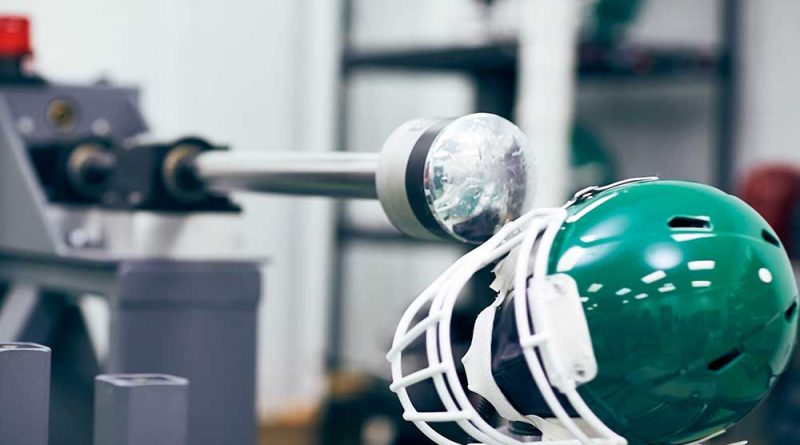As health concerns rise, safety efforts focus on improving helmets, detecting head injury
By MICHAEL ROVETTO and ABBEY WELTMAN
Capital News Service
The risk of head injury in youth tackle football can never be eliminated. But around the country, changes in rules and standards are being introduced to try to reduce those risks.
Some leagues are appointing special coaches to watch for injuries during games. Football equipment is being reexamined. In July, the National Operating Committee on Standards for Athletic Equipment (NOCSAE) announced it was nearing approval of a standard specifically for youth football helmets — a first.
Until recent years, “we haven’t known enough about those risks at the youth level to do anything much with the standard other than make sure that there were sizes that fit,” said Mike Oliver, executive director and general counsel for NOCSAE. As research has progressed, it has become possible to create a “more tailored” standard for youth helmets, Oliver said.
Under NOCSAE’s proposal, helmets for children ages 5-13 would weigh no more than 3.5 pounds or “about half of what most helmets are currently on the market,” said Dr. Robert Cantu, NOCSAE vice president and chairman of its Scientific Advisory Committee.
Lighter helmets will protect youth players from concussions, Cantu said, explaining that children’s necks are weaker than the necks of adults. When children fall backward to the turf, their heads are more likely to snap back. This rapid reverse movement can cause more damage than the original impact.
“The falls to the ground [produce] as many or more concussions as the actual hits while they were hitting standing up,” said Cantu, who also is clinical diagnostics and therapeutics leader of the Boston University CTE Center.
NOCSAE sets safety standards for the sports equipment industry, but it could be years before lighter helmets approved by NOCSAE are on the heads of youth players. Even after approval of a new standard, it will take a year or more before the youth helmet is available.
Cantu predicted improved safety for all young players when the helmets are widely in use, especially for the youngest players, ages 5-9, whose necks are weakest. The new helmets will be the “real deal and very important,” he said.
Overall, safety measures for youth football have been slow to develop.
In 2015, USA Football, the governing body of the sport, announced a recommended limit of 30 minutes of contact a day and four team practices each week.
In 2019, Pop Warner Little Scholars, the largest youth football organization in the country, eliminated the “three-point stance” for players from ages 5 to 10, a change aimed at reducing the clashing of helmets at the line of scrimmage.
Some leagues have gone beyond the rules and guidelines of national organizations. In the Tualatin Valley Youth Football League, located in communities near Portland, Oregon, officials have adopted rules, including the appointment of a league director of player safety, and have added an app to track players’ injuries.
Brian Lyles, commissioner of the Tualatin Valley league said, “Leagues that don’t adopt this view of player safety and safety first — unfortunately, it affects all of us. … If you don’t adopt that, you’re going to struggle bringing people in.”
Each team in the Tualatin Valley league is assigned a safety coordinator who is responsible for identifying players who display symptoms of an injury. The coordinator has the authority to pull players from games and practices if warranted.
Every coach also is certified through USA Football’s Heads Up program. This includes training in concussion recognition and response, heat preparedness and hydration, and sudden cardiac arrest. Coaches also are trained to properly fit equipment and teach safer techniques for tackling and blocking.
Safety coordinators are prohibited from acting as offensive or defensive coordinators and head coaches. Starting next season, league rules will prohibit safety coordinators from having any role in coaching any team in the league, Lyles said. The change ensures the safety coaches only have allegiance to player safety, he added.
The Tualatin Valley league partnered with the Positive Coaching Alliance, an organization that promotes beneficial youth sports experiences. Casey U’Ren, a PCA vice president, said the Tualatin Valley league is one of many youth sports programs working with PCA to take more progressive action prioritizing player safety.
Flag football is another way some coaches and parents are trying to make the game safer. Flag, in which players grab strips of fabric instead of each other, is expanding rapidly.
Toby Bourguet, founder of Tucson Turf, a youth flag football league in Tucson, Arizona, started his organization in part as a tackle alternative for his six children. Two of his sons now play football at Arizona State University.
“I love tackle football as much as any person you will talk to. But not as much as I love my children and their health,” Bourguet said.
Growth in flag leagues and safety initiatives have been a response in part to mounting medical evidence of the dangers related to taking head impacts over many seasons.
A study published by Boston University researchers last March found repetitive blows to the head like the ones that occur in youth football can lead to “impulsive behavior and other thinking-related problems.” The study, published in the journal Brain Communications, shows children are at greater risk if they start playing tackle football at an early age or play for more than 11 years.

More research needs to be done to understand all the risks, Cantu said. He predicts scientists eventually will be able to measure precisely the trauma each hit to the head delivers to a player. “From that,” he said, “we’re going to be able to know: Is somebody reaching a kind of a yellow zone that is getting close to the red light?”
Steve Rowson, associate professor of biomedical engineering at Virginia Tech, director of the Virginia Tech helmet lab and member of the scientific advisory committee for NOCSAE, said genetic factors could possibly predispose some people who take head blows to suffer concussion symptoms and later-life diseases such as dementia. Rowson said that isn’t well understood now.
“Why does one person get hurt when they get hit in the head like this and not another?” Rowson asked. He said more factors need to be studied to determine how they increase risks to players.
Advances in research over the next decade will continue to change the rules and influence public opinion about the safety of the sport for children, according to advocates such as Chris Nowinski, co-founder and CEO of the Concussion Legacy Foundation.
Nowinski, a former Harvard University football player turned WWE professional wrestler, sustained multiple concussions during his football and wrestling careers. His organization urges parents not to allow their children to play tackle football until the age of 14.
“Youth tackle,” he said, “I don’t think should exist.
“I don’t think there’s any reason to play tackle football before high school, before 14,” Nowiniski said. “But I’m open to a compromise if we can protect the youngest and most vulnerable brains.”
Please read the first part of the series here.

Capital News Service is a student-powered news organization run by the University of Maryland Philip Merrill College of Journalism. With bureaus in Annapolis and Washington run by professional journalists with decades of experience, they deliver news in multiple formats via partner news organizations and a destination Website.

